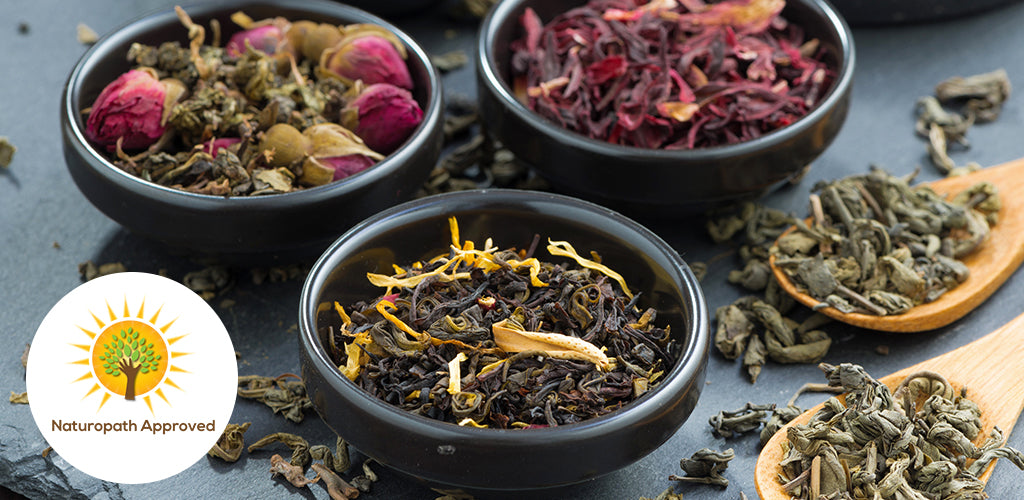Blending functional teas with naturopath Amy Castle

Most Australians remember the ‘aunty who’ ad that first got us thinking about the health benefits of a cuppa. Fast forward to today and there is increasing research into the positive effects of green, black and herbal teas on our overall wellbeing. So to ensure our herbs, spices and functional blends meet naturopathic standards, we now have a certified naturopath on the team, Amy Castle (BHSc). She’s shared her top tips for blending teas that both taste great and exert functional benefits.
What led you into tea?
Herbal medicine is one of the foundational units of naturopathy study. Learning about a wide array of herbal medicines and their uses led me to experiment with and appreciate the herbal and camellia sinensis families of teas – especially green tea.
What types of tea do you drink on a daily basis and why?
Organic sencha green tea. I love the delicate flavour of sencha, the protective health effects that can come with its regular consumption and the gentle buzz of green tea. I also drink a range of herbal teas including holy basil, lemon balm, ginger and chamomile, for the nervous system and digestive support that these teas provide.
One of my favourite recipes is 1–2 tsp of organic turmeric powder mixed with ginger, cinnamon and black pepper powder. I add hot water to this and top it with coconut milk daily. The spice mix is delicious and exerts antioxidant and anti-inflammatory effects.
We are seeing growth in functional teas at the moment – why are consumers become interested in the links between tea and health?
Health awareness is growing exponentially, and that naturally moves people into a deeper consciousness of their environment and what they put into their bodies. Teas are accessible, affordable, have therapeutic potential, taste delicious and are generally safe for the majority of people. And as such, they have a very wide appeal.
We also have access to more and more research supporting the medicinal properties of herbs, as well as green tea and other teas from the camellia sinensis family. So this also likely plays a role.
When assessing a tea to endorse it with a Naturopath Certificate of Approval, what are you looking for?
First for a Naturopath Certificate, I assess the safety of the blend for those who will consume it. Most herbal teas are safe to consume, but there are always exceptions to the rule for certain individuals. Then I look at the functionality of the therapeutic effects at the recommended dosage, and the tea’s suitability to its intended market and purpose.
After this, I turn my attention to the synergy and harmony of the blend, quality of the raw ingredients and the certified organic status.
While I am more concerned with the functionality of teas in this case, it is still important that the flavour and aesthetics of the tea are considered too, as these elements can greatly affect compliance and the enjoyment of tea drinking.
Can you recommend some effective herbs and spices that teamakers should be experimenting with?
Tulsi (holy basil) is one of my favourite herbs in terms of wide-reaching benefits. Many people really get to love the taste and enjoy the benefits it may provide, such as supporting the stress response, immune support and antioxidant cognitive support.
Ginger also has a wide range of applications including anti-inflammatory effects, digestive support and anti-anxiety effects – and it is a great synergist with other herbs.
What are your tips for communicating the health benefits of a tea or tisane blend in a way that consumers can easily understand?
Use simple language that’s easy to understand, but also make sure you include some general technical information for those who are interested in it. These days many people like to be better informed about their health, so it is important to provide more in-depth information here.
Start with a general description of the tea’s benefits, a brief description of the key herbs and their actions, and directions for use. If you’re not sure about your compliance from a labelling perspective, see the health claims and organic sections in our tea labelling guide.
Finally, what’s the secret to blending a tea or tisane that’s both functional and delicious?
Starting with an understanding of the desired outcome and target market for the tea will lead you to the appropriate herbs and spices for the blend. I will usually note the required actions of the herbs (just as I would in a naturopathic consultation), as this helps to narrow and focus the selection of herbs and spices.
I then consider a theme or focus in terms of flavour – for example, a floral or a fresh citrus theme to work with – and start sampling combinations of the appropriate selected herbs. Once you have done this at least a few times, you will get an idea of what flavour combinations are likely to work so you are not always starting from scratch.
Finally, get some other opinions in terms of flavour to assess the tea for a wide appeal, and ideally trial the tea with some willing subjects to assess its functionality.
Amy is working with us to expand our range of functional teas, develop custom blends for clients and assess your blends for their health benefits. Here’s how you can grow your functional tea offering by collaborating with Amy.

For all the tips and tea trends we pick up through our global network, subscribe at the bottom of this page for fortnightly updates.
- Melinda Halloran







Comments 1
cari
lovely article and i look forward to working with you all more in the future!